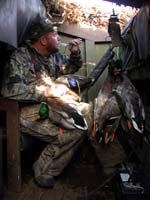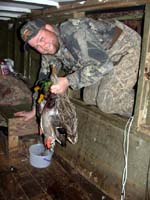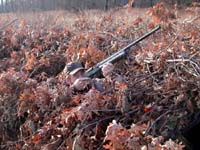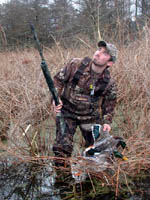
|
Features
|
|
|
|
Books
|
|
|
|
Fun & Games
|
|
|
|
Contact Us
|
|
|
John's Journal... Entry 178, Day 2
YO-YO DUCKS
Calls, Shells and Spreads
 EDITOR'S
NOTE: For more than 20 years Billy Blakely of Troy,
Tennessee, has guided duck hunters on Reelfoot Lake in Tiptonville, Tennessee.
Reelfoot Lake is 18,765 acres of water that was formed by a series of
earthquakes that started in December of 1811 and ended in February of
1812. At that time the Mississippi River flowed backwards and spilled
over into the hole left by the earthquakes, creating Reelfoot Lake. Loaded
with shallow-water flats, cypress swamps and plenty of shallow-water areas,
this lake homes ideal duck habitat. And to make this haven for duck hunters
even better, one state and two federal waterfowl refugees are located
around the lake. Another reason Reelfoot Lake has the most-dependable
duck hunting of any area I know in the United States is due to the yo-yo
effect this area experiences during waterfowl season.
EDITOR'S
NOTE: For more than 20 years Billy Blakely of Troy,
Tennessee, has guided duck hunters on Reelfoot Lake in Tiptonville, Tennessee.
Reelfoot Lake is 18,765 acres of water that was formed by a series of
earthquakes that started in December of 1811 and ended in February of
1812. At that time the Mississippi River flowed backwards and spilled
over into the hole left by the earthquakes, creating Reelfoot Lake. Loaded
with shallow-water flats, cypress swamps and plenty of shallow-water areas,
this lake homes ideal duck habitat. And to make this haven for duck hunters
even better, one state and two federal waterfowl refugees are located
around the lake. Another reason Reelfoot Lake has the most-dependable
duck hunting of any area I know in the United States is due to the yo-yo
effect this area experiences during waterfowl season.
"When the weather is cold, the ducks migrate from the North to Reelfoot," Blakely explains. "When the weather turns hot, the ducks that travel north from Mississippi and Louisiana also stop here. Reelfoot Lake seems to be the midpoint of the two extremes of weather during waterfowl season." This week we'll learn how Blakely and the other guides at Blue Bank Resort consistently take ducks at this time of the year.
 Question:
How do you get high-flying flocks of ducks to come in to your decoys?
Question:
How do you get high-flying flocks of ducks to come in to your decoys?
Blakely: I use a very high-pitched duck call, and I do a lot of highball
calling. I believe you have to blow the calls loudly and excitedly to
get those high-flying ducks to look at your blind and your decoys instead
of someone else's spread. The guides here will call to a lot of high-flying
ducks that duck hunters in other areas of the country would not think
of calling. Because we use a large number of decoys, many times we'll
get those high-flying ducks' attention and pull them down to our decoy
spread. I'll call the ducks aggressively until I can get them down to
the point where I can soft-call them. If you're hunting ducks in a rice
field or in flooded timber, you can call to the ducks lightly and let
the ducks see the decoys to pull in the ducks. But here on Reelfoot Lake,
we have to call a lot, we have to call loudly, and we have to call aggressively
until the ducks set their wings to come in to light. Question: What kind
of call do you use? Blakely: I use a Haydel double-reed call, the DR85.
This call delivers a loud, high-pitched call that practically reaches
out and touches the ducks.
Question: What type of shot shell do you recommend?
 Blakely:
I really like the Remington Hevi Shot. Many times our ducks will come
in a little bit wide, and you'll need a shell that will reach 40, 50 and
even 60 yards. Not only will this Hevi shot down the ducks at that range,
but in most cases it will penetrate the ducks. So when you get ready to
eat the ducks, you won't be biting into shot. I've noticed that the Hevi
shot also results in fewer cripples and fewer ducks getting away. Another
advantage to using the Hevi shot is that you don't have to lead the ducks
as much as you will when using steel shot.
Blakely:
I really like the Remington Hevi Shot. Many times our ducks will come
in a little bit wide, and you'll need a shell that will reach 40, 50 and
even 60 yards. Not only will this Hevi shot down the ducks at that range,
but in most cases it will penetrate the ducks. So when you get ready to
eat the ducks, you won't be biting into shot. I've noticed that the Hevi
shot also results in fewer cripples and fewer ducks getting away. Another
advantage to using the Hevi shot is that you don't have to lead the ducks
as much as you will when using steel shot.
Question: How far in front of the ducks will you normally
lead with steel shot, and how does your lead change when you're shooting
Remington Hevi Shot?
Blakely: If a duck is coming from left to right with steel shot, you normally
shoot about 9 feet in front of the duck. With Remington Hevi Shot, you
only have to shoot about 5 ½ to 6 feet in front of the duck.
Question: How is your decoy spread set up?
 Blakely:
Directly in front of the blind, I place my newest mallard decoys. I put
a few coot decoys in with the mallard decoys because any time you have
something black in your decoy spread, the ducks can see the spread better.
If you set two decoys on the water and get a long way from them, you'll
be able to see the black decoy much easier than to the painted decoy.
This is why I use so many Filler Killer decoys in my spread. I believe
that the Filler Killers enable the ducks to see my decoy spread better
from farther away than if I don't use them. The Filler Killer decoys are
as big as goose decoys, and the ducks can see them and will come into
them much faster than if we didn't have those big black bottles floating.
The Filler Killers get the attention of the ducks that are high and cause
those ducks to drop down to take a better look at the decoy spread. Once
they see the spread, the ducks usually will try to light close to the
more natural-looking decoys. I also put Canada goose decoys on the side
of my spread because I think they help me pull me in high-flying ducks.
Occasionally we'll get a few geese that fly past the blind, and those
goose decoys gives us a chance to call in those geese. In addition, I
set out gadwall decoys in small groups on the edge of the hole where I
want my ducks to land. Oftentimes gadwalls will drop in to those decoys
and try to land close to them instead of lighting near my mallard decoys.
So I'll keep at least one or two groups of gadwall decoys close to my
blind at all times.
Blakely:
Directly in front of the blind, I place my newest mallard decoys. I put
a few coot decoys in with the mallard decoys because any time you have
something black in your decoy spread, the ducks can see the spread better.
If you set two decoys on the water and get a long way from them, you'll
be able to see the black decoy much easier than to the painted decoy.
This is why I use so many Filler Killer decoys in my spread. I believe
that the Filler Killers enable the ducks to see my decoy spread better
from farther away than if I don't use them. The Filler Killer decoys are
as big as goose decoys, and the ducks can see them and will come into
them much faster than if we didn't have those big black bottles floating.
The Filler Killers get the attention of the ducks that are high and cause
those ducks to drop down to take a better look at the decoy spread. Once
they see the spread, the ducks usually will try to light close to the
more natural-looking decoys. I also put Canada goose decoys on the side
of my spread because I think they help me pull me in high-flying ducks.
Occasionally we'll get a few geese that fly past the blind, and those
goose decoys gives us a chance to call in those geese. In addition, I
set out gadwall decoys in small groups on the edge of the hole where I
want my ducks to land. Oftentimes gadwalls will drop in to those decoys
and try to land close to them instead of lighting near my mallard decoys.
So I'll keep at least one or two groups of gadwall decoys close to my
blind at all times.
For more information on hunting at Reelfoot Lake, call the Blue Bank Resort at 731-253-6878, visit www.bluebankresort.com, or write to Blue Bank at Route 1 Box 970, Tiptonville, TN 38079. To learn more about Filler Killer duck decoys, call (800) 659-7303, or visit www.agsouthco.com. Go to Haydel's Web site at www.haydels.com or call (318) 746-3586 to learn more about the company's quality duck calls. Contact Remington at (800) 243-9700 or visit www.remington.com for more information on Hevi Shot.
Check back each day this week for more about YO-YO DUCKS ...
Day 1 - Decoys and Blinds
Day 2 - Calls, Shells and Spreads
Day 3 - Basic Duck-Hunting Tips
Day 4 - Best Days of Duck Hunting
Day 5 - Open-Water Hunts